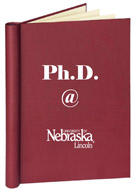Graduate Studies, UNL

Dissertations and Doctoral Documents from University of Nebraska-Lincoln, 2023–
First Advisor
Benny E. Mote
Degree Name
Doctor of Philosophy (Ph.D.)
Department
Animal Science (Breeding and Genetics)
Date of this Version
8-2024
Document Type
Dissertation
Citation
A dissertation presented to the faculty of the Graduate College of the University of Nebraska in partial fulfillment of requirements for the degree of Doctor of Philosophy
Major: Animal Science (Breeding and Genetics)
Under the supervision of Professor Benny E. Mote
Lincoln, Nebraska, August 2024
Abstract
Feed costs are the largest contributor towards the variable costs of pork production. To decrease feed cost while not sacrificing output requires an improvement in feed efficiency (FE). A potential approach to expand available phenotypes associated with FE is with activity tracking, yet the relationship between activity and performance is not well defined in swine. Therefore, the objective of this study was to quantify associations between activity and feed intake traits. Average daily feed intake (ADFI) was collected on 1,766 purebred boars of three genetic lines (Duroc, Landrace, and Yorkshire) using FIRE (Osborne Industries, Inc., Osborne, Kansas) at a testing facility in central USA. Activity traits (Distance travelled (DIST); Total lie time (LIE); and Eat time (EAT) were quantified via NUtrack. Carcass traits scanned at off-test included backfat (BF) and loin-eye depth (LED). For growth, Duroc boars were the fastest (P < 0.05) growing (1.04 kg/d) and heaviest (P < 0.05) at off-test (110.58 kg), whereas Yorkshires were the slowest (P < 0.05) growing (0.88 kg/d) and lightest (P < 0.05) at off-test (98.09 kg). Landrace boars were intermediate (P< 0.05) for both ADG and off-test weight (0.94 kg/d and 102.86 kg, respectively). The same ranking of boars (P < 0.05) was observed for ADFI at 2.38, 2.13, and 2.00 kg/d, respectively). Duroc and Landrace boars had less (P < 0.05) BF compared to Yorkshire boars (8.37, 8.42, and 8.64 mm, respectively), whereas Landrace boars had a lower (P < 0.05) LED compared to Duroc and Yorkshire boars (64.00, 66.92, and 66.87 mm, respectively). Duroc boars spent more time (P < 0.05) lying and travelled the least (P < 0.05) distance per day at 1,257.66 min/d and 548.42 m/d, respectively. Landrace boars travelled further (P < 0.05) per day compared to Yorkshire boars (806.40 vs. 718.02 m/d), but did not differ (P > 0.05) in LIE (1,188.31 vs. 1,191.66 min/d). Duroc and Yorkshire boars spent less time (P < 0.05) at the feeder per day than Landrace boars (86.58, 84.42, and 98.28 min/d, respectively). Phenotypic correlations between DIST and ADFI, ADG, BF, and LED were -0.13, -0.26, 0.26, and -0.41, respectively. For the same traits, phenotypic associations with LIE were 0.36, 0.44, 0.20, and 0.40, respectively. For EAT, correlations with the same traits were -0.11, -0.48, 0.07, and 0.02, respectively. Activity levels in pigs does impact growth and performance, with faster growing animals being less active. Clear breed differences were observed for both performance and activity traits. Selection for lower activity levels in terminal lines may be one way to further improve efficiency.
Advisor: Benny E. Mote
Recommended Citation
Obermier, Dalton R., "Investigating Associations between Activity and Performance Traits across Three Breeds of Swine Using Nutrack" (2024). Dissertations and Doctoral Documents from University of Nebraska-Lincoln, 2023–. 146.
https://digitalcommons.unl.edu/dissunl/146


Comments
Copyright 2024, Dalton R. Obermier. Used by permission